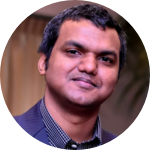About This Project
An aging structure needs to be investigated periodically to prevent catastrophic failure. Crack development is one of the major concern for a structure in service. Early crack detection prevents catastrophic failure and can provide safety. When crack grows, it releases energy as acoustic emission (AE) waveform. AE waveform can be used to diagnose the state of the structure. Here a novel method is proposed to extract crack growth information from AE waveform using energy approach.
Ask the Scientists
Join The DiscussionWhat is the context of this research?
This research focuses on developing an efficient and cost effective approach for in-situ crack detection. A successful crack detection procedure depends on the appropriate methodology to implement. In this proposal, a novel method is proposed to extract AE source (crack related) information using energy approach. The objective is to characterize the source from a crack growth by analyzing the AE signal. According to the new concepts if one can characterize the source, it will provide the energy released information from the crack, and that can be correlated directly with the crack growth. This crack detection technique allows (a) optimal use of the structure (b) a minimized downtime (c) the avoidance of catastrophic failures (d) reduce the maintenance services.
What is the significance of this project?
In practical applications, incremental crack growth in a structure provides AE waveform that can be recorded by a sensor attached to the structure. Periodic investigation of AE waveform can give the insight information of the crack growth. However, extracting AE source feature (crack-related information) from a recorded AE waveform is always challenging, and the underlying physics is much more complicated. This new technique can be used to extract crack growth information efficiently and accurately. Therefore, this research would be useful for early crack detection and preventing catastrophic failure with minimal effort and cost. The outcome of this project could directly be applied to the SHM applications of aerospace, defense, civil infrastructure, etc.
What are the goals of the project?
For implementing the new concept, an AE experiment will be designed to measure the acoustic emissions from the fatigue crack growth. The AE sensor will be attached to the specimen to capture the AE signals. The AE instruments record the signals as AE waveforms. An inverse algorithm will be developed to characterize the source from AE signal. In inverse algorithm, the source parameters will be calculated. Source parameters provide the insight information about the crack growth in a structure. Once source parameters from AE signal is obtained then the crack growth rate can be determined. A forward problem will also be solved to simulate the AE guided wave using the released energy calculated from experiments and then the simulated signal will be compared to the experimental signal.
Budget
I am a graduate student and my primary research focus is structural health monitoring using ultrasonic guided waves. The major component of my PhD dissertation work involves analysis of AE guided wave using Helmholtz potential (energy) approach. This is fundamental research, and only preliminary theoretical analysis has been done so far. This project will help me to complete the work and take this fundamental research to the application level. In addition, this funding will allow me to share and discuss our research results, exchange innovative ideas, and keep up with the most pioneer progresses in my field of study.
I will be working 6 months during Summer and Fall 2018 (10 hours per week)
Total hours = 6*(4*10) = 240; Hourly rate = $12.5; Total salary (with the fringe rate) = $4110.
Fringe rate info: https://sc.edu/about/offices_and_divisions/sponsored_awards_management/essential_reference_information/fringe_benefits.php
Material cost: Steel plate (304) 36"x48" cost is $95
Endorsed by
 Project Timeline
Project Timeline
This work will be completed with 6 month time frame. The project will start stating June and will be completed at the end of November. After the main experiment verification are done (Month 5-6), this project will be presented at a conference. One journal publication is expected by the end of this project .
May 01, 2018
Project Launched
Jun 01, 2018
Project Start
Jun 15, 2018
Goal: Study and design the experiments Milestone: Obtain the experimental parameters
Jul 30, 2018
Goal: Conduct the AE experiments Milestone: AE signal from fatigue crack growth
Aug 30, 2018
Goal: Developing an inverse algorithm Milestone: Path towards deconvolution
Meet the Team
Affiliates
Mohammad Faisal Haider
This is Mohammad Faisal Haider. I am a research oriented professional with more than five years of research experience contributing to ultrasonic guided waves, piezoelectric wafer active sensors, composite materials, dielectric materials, multi-physics behavior of composite materials structural sensing and sensor methods for SHM/NDE. I am holding M.S. and B.S. degree in mechanical engineering. I have earned my M.S. from University of South Carolina and B.S. from Bangladesh University of Engineering and Technology. Now, I am a Graduate Research Assistant (PhD) in Mechanical Engineering Department of University of South Carolina.
I have received several awards for my outstanding results during my BS and MS studies. I have published 27 journal articles, conference papers and technical reports.
My future goal in life is to work in academia as well as to pursue high-end research. After completing my doctoral studies , I will be seeking for a faculty position. I always believe that working with the aim of providing people more accessible, economical, reliable and contributive technology is the best way to serve the society with the blessings of science.
Google scholar account: https://scholar.google.com/cit...
Project Backers
- 19Backers
- 103%Funded
- $4,337Total Donations
- $129.83Average Donation



